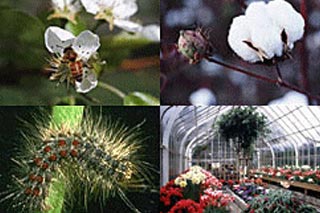In coordination with Penn State's School of Forestry and College of Agriculture, we began growing genetically engineered BC1and BC3 generation chestnuts at the Wood House Farm in 2006, just a year after planting about 40 100% American chestnuts (Castanea dentata). We currently have over 70 chestnuts (representatives of or hybrids of C. dentata and C. mollissima) at different life stages.
from PSMag.com:
Is the genetically engineered chestnut tree an act of ecological restoration or a threat to wild forests?
 The day after Earth Day at the New York Botanical Garden was one of
those spring stunners when half the city had come out to get their
nature fix after a long, gray winter. Couples lolled on the lawns and
shot photos of babies beneath blossoming crab apples. Parents pushing
strollers past Azalea Garden and up Daffodil Hill eyed me suspiciously
as I sidled up to a scraggly bare tree beside the path.
The day after Earth Day at the New York Botanical Garden was one of
those spring stunners when half the city had come out to get their
nature fix after a long, gray winter. Couples lolled on the lawns and
shot photos of babies beneath blossoming crab apples. Parents pushing
strollers past Azalea Garden and up Daffodil Hill eyed me suspiciously
as I sidled up to a scraggly bare tree beside the path.
Amid 250 acres of gorgeous organisms, this specimen was the homeliest of the bunch. Twelve feet tall, with spindly gray branches and raw cankers shredding its trunk, it was not likely to be featured in any baby photos that day. Yet I had come all the way from Vermont to see it. The draw for me wasn't looks; it was the fact that the tree was alive at all. Here was a 10-year-old American chestnut, one of the first in a century to make it that long.
The American chestnut has been called the redwood of the East. From Georgia to Maine, up and
from PSMag.com:
Is the genetically engineered chestnut tree an act of ecological restoration or a threat to wild forests?
 The day after Earth Day at the New York Botanical Garden was one of
those spring stunners when half the city had come out to get their
nature fix after a long, gray winter. Couples lolled on the lawns and
shot photos of babies beneath blossoming crab apples. Parents pushing
strollers past Azalea Garden and up Daffodil Hill eyed me suspiciously
as I sidled up to a scraggly bare tree beside the path.
The day after Earth Day at the New York Botanical Garden was one of
those spring stunners when half the city had come out to get their
nature fix after a long, gray winter. Couples lolled on the lawns and
shot photos of babies beneath blossoming crab apples. Parents pushing
strollers past Azalea Garden and up Daffodil Hill eyed me suspiciously
as I sidled up to a scraggly bare tree beside the path.Amid 250 acres of gorgeous organisms, this specimen was the homeliest of the bunch. Twelve feet tall, with spindly gray branches and raw cankers shredding its trunk, it was not likely to be featured in any baby photos that day. Yet I had come all the way from Vermont to see it. The draw for me wasn't looks; it was the fact that the tree was alive at all. Here was a 10-year-old American chestnut, one of the first in a century to make it that long.
The American chestnut has been called the redwood of the East. From Georgia to Maine, up and



